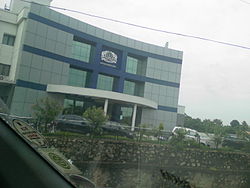History
Beginnings in Kottayam
Malayala Manorama Company is a private LLC corporation, owned by the Kandathil family, an aristocratic Malankara Orthodox Syrian Christian family, [7] incorporated by Kandathil Varghese Mappillai at Kottayam in south-western Kerala on 14 March 1888. The company started with one hundred shares of ₹100 each. The investors paid in four equal instalments. With the first instalment, the company brought a London-made Hopkinson and Cope press. A local craftsman, Konthi Achari, was hired to make Malayalam types for the imported press. [8]
Varghese Mappillai had worked for a year as editor of Kerala Mitram, a Malayalam newspaper run by Gujarati businessman Devji Bhimji, in Cochin and he took over the same position for Manorama. The Maharajah of Travancore Moolam Thirunal approved the logo of the newspaper which was a slight modification of the Travancore Coat of Arms. [9]
The first issue was published on 22 March 1890 from Orthodox Theological Seminary, Kottayam, while the town was hosting a popular cattle fair. It was a four-page weekly newspaper, published on Saturdays. The weekly newspaper became a bi-weekly in 1901, a tri-weekly on 2 July 1918 and a daily on 2 July 1928. [10] After Varghese Mappillai's death in 1904, his nephew K. C. Mammen Mappillai took over as editor.
In 1938, Travancore state proscribed Malayala Manorama on charges of publishing news against the Diwan; Mammen Mappillai was convicted and imprisoned. Malayala Manorama re-commenced regular publication in 1947 after the Indian independence and the Diwan's downfall.
On Mammen Mappillai's death, his eldest son K. M. Cheriyan took over as the Editor-in-Chief in 1954. At this time, Malayala Manorama was produced in a single edition in Kottayam with a circulation of 28,666 copies. [11]
By the late 1950s, Manorama steadily increased circulation and overtook in circulation Mathrubhumi , the dominant Malayalam daily at the time.
Expansion across Kerala (1960s)
The struggle between Malayala Manorama (based in Kottayam) and Mathrubhumi (based in Kozhikode) demonstrated the forces that would drive the expansion of Indian regional newspapers. The contest also illustrated the difficulties if expansion had to rely on Gutenberg-style printing as with the case of Manorama. [12]
Comparison of circulation Malayala Manorama and Mathrubhumi(from India's Newspaper Revolution (2000) by Robin Jeffrey, Western Influence on Malayalam Language and Literature (1972) by K. M. George and Audit Bureau of Circulations (ABC) 2013)
500
1,000
1,500
2,000
2,500
3,000
1927
1937
1947
1957
1960
1964
1968
1970
1981
1998
2013
In 1962, Mathrubhumi launched its second edition in Kochi. The new edition sent Mathrubumi to a circulation of 170,000 copies by 1964, 19,000 more than its rival, Malayala Manorama. With Mathrubhoomi's circulation rising, it became a compulsion for Manorama to expand its reach, and consequently, introduce new technology. The competition set off a keen struggle for more readers, faster equipment and national advertising from major consumer goods companies [such as Hindustan Unilever]. [11] Manorama launched its printing centre at Kozhikode, Malabar in 1966 with a cast-off press from the paper's base at Kottayam and hand-composed type. [13] But in the run-up to that event, it had installed an offset press at Kottayam and established a teleprinter line with New Delhi in 1965.
By 1970, it was the leading daily in Kerala. The circulation of the newspaper rose from around 30,000 to 300,000 by this expansion across the Malabar Coast. [10] [14]
1980s
K. M. Mathew, who took charge as editor in 1973, began a series of renovations, just as the Anandabazar Patrika did in Bengal. He brought in a series of consultants in the management [1979], technical and editorial areas, and accepted their guidance. He conducted frequent training sessions for Manorama journalists and other employees. The company restructured their organisation in 1980. [15] K. M. Mathew said that the decision stemmed from the realisation that the daily had either to become "fully professional" or "risk decline". Mathew sent his best journalists and managers to training schools around the world and imported the most effective techniques in international journalism and newspaper production, which brought a contemporary look and feel to Malayala Manorama. [11] In 1979, a new printing centre was launched at Kochi and in 1987, the Thiruvananthapuram edition was also launched. By 1998, the circulation of Malayala Manorama was increased to 1 million. [16] [17] In the mid-2000s, the daily started units in the Middle East, focusing on the large Malayali population in the region. Mathew is credited with the introduction of the concept of "editionalising" with a larger share of local news and reader-friendly packaging through professional page designing in Manorama, which in turn impacted the entire newspaper industry in Kerala. By 2007, Manorama become the only non-English and non-Hindi daily newspaper in India to cross 1.5 million copies in circulation. [18] [19]
K. M. Mathew was succeeded by his son Mammen Mathew in 2010. In their obituary The Hindu praised Mathew as,
"In what could only be described as a rarity then in Indian language journalism, Mathew showed an unusual commitment to modernisation and professionalism and became a role model for the newspaper industry, which in the early 1980s was at the critical juncture of embarking on a phase of unbelievable expansion." [11]
According to the Audit Bureau of Circulations's (ABC) January–June 2013 figures, Malayala Manorama holds a circulation of 2.1 million readers. [20]
1990s
Malayala Manorama launched its official Malayalam language news website called Manorama Online [21] in 1995. After three years, in 1998, Malayala Manorama launched its English News Website Onmanorama . [22]
This page is based on this
Wikipedia article Text is available under the
CC BY-SA 4.0 license; additional terms may apply.
Images, videos and audio are available under their respective licenses.



